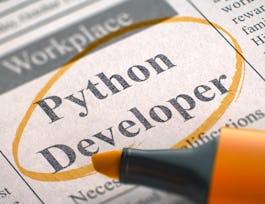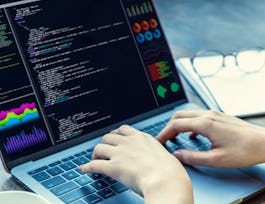By the end of this course, you’ll be able to manipulate files and processes on your computer’s operating system. You’ll also have learned about regular expressions -- a very powerful tool for processing text files -- and you’ll get practice using the Linux command line on a virtual machine. And, this might feel like a stretch right now, but you’ll also write a program that processes a bunch of errors in an actual log file and then generates a summary file. That’s a super useful skill for IT Specialists to know.



Using Python to Interact with the Operating System
This course is part of Google IT Automation with Python Professional Certificate

Instructor: Google Career Certificates
Top Instructor
Sponsored by School Of Open Learning
262,180 already enrolled
(6,413 reviews)
What you'll learn
Setup, configure, and use your own developer environment in Python
Manipulate files and processes running on the Operating System using Python
Understand and use regular expressions (regex), a powerful tool for processing text files
Know when to choose Bash or Python, and create small scripts using Bash
Details to know

Add to your LinkedIn profile
24 assignments
See how employees at top companies are mastering in-demand skills

Build your Support and Operations expertise
- Learn new concepts from industry experts
- Gain a foundational understanding of a subject or tool
- Develop job-relevant skills with hands-on projects
- Earn a shareable career certificate from Google


Earn a career certificate
Add this credential to your LinkedIn profile, resume, or CV
Share it on social media and in your performance review

There are 7 modules in this course
In this module, you’ll learn about the different types of operating systems, and how you can get your python code ready to interact with the operating system. We’ll learn about getting your environment set up and installing additional Python modules that will help you along the way. We’ll rundown interpreted versus compiled language, and how they differ from each other. We’ll dive into the benefits of automation, and point out common pitfalls so you can avoid them. Finally, we’ll learn about Qwiklabs, which will be used for graded assessments.
What's included
15 videos6 readings4 assignments
In this module, you’ll learn about reading and writing to files and the commands that will enable you to do this. We’ll learn the importance of managing files and how we can navigate through different directories. You’ll understand how to work with files and how there is a layer of abstraction between Python and the operating system. Finally, we’ll dive into learning about CSV files and how to best utilize them.
What's included
15 videos16 readings4 assignments1 app item1 ungraded lab
In this module, you’ll learn about what a regular expression is and why you would use one. We’ll dive into the basics of regular expressions and give examples of wildcards, repetition qualifiers, escapare characters, and more. Next up, we’ll explore advanced regular expressions and deep dive on repetition qualifiers. You’ll tackle new exercises like capturing groups and extracting PIDs using regexes. Finally, we’ll provide a study guide to serve as your go-to guide for regular expressions.
What's included
14 videos14 readings4 assignments1 app item
In this module, you’ll learn about reading and writing to data files based on an interaction with the user. Along the way, we’ll dive into standard streams, environment variables, and command line arguments. Next, we’ll jump into Python subprocesses, including system commands and how they can be used. We’ll review how to obtain output from a system command, and dive into subprocess management, including how to check exit values and manipulate the normal versus error exit values. Finally, we’ll rundown processing log files, and will cover what a log file is, how to filter log files using regular expressions, and how to understand the output captured from log files.
What's included
12 videos13 readings4 assignments1 app item
In this module, you’ll learn how to create tests in Python. We’ll cover what testing is all about and dive into the differences between manual versus automated testing. Next, we’ll explore what unit tests are intended to do and how to write them. Then, we’ll learn about other test concepts like black box versus white box tests and how test-driven development can frame how you design and write your code. Finally, you’ll learn about errors and exceptions, and how to combat them.
What's included
14 videos16 readings3 assignments1 app item2 ungraded labs
In this module, you’ll be exposed to what the Linux OS has to offer and you'll learn about Bash scripting. We’ll go over basic Linux commands and explore the many processes Linux has to offer, including a key concept called redirection. We’ll then deep dive into creating Bash scripts using variables and globs. Finally, we’ll learn about advanced Bash concepts and develop an understanding of when to use Bash versus Python.
What's included
13 videos17 readings4 assignments1 app item
In this module, you’ll put everything you’ve learned so far into action! You’ll apply your scripting knowledge to tackle a challenging final project: writing a script that scans for a specific error in the log files. You'll create a problem statement to understand the challenge, conduct some research to see what options are available, then begin planning how you intend to solve the problem. Lastly, you'll write the code to implement your solution!
What's included
7 videos7 readings1 assignment1 app item
Instructor

Offered by
Why people choose Coursera for their career




Learner reviews
6,413 reviews
- 5 stars
78.09%
- 4 stars
15.85%
- 3 stars
3.49%
- 2 stars
1.19%
- 1 star
1.35%
Showing 3 of 6413
Reviewed on Jul 8, 2020
It is a wonderful course, I've learned a lot within the classes, and I am ready to use this knowledge to develop my own projects. It a little bit extensive, but to accomplish it is rewarding.
Reviewed on Oct 6, 2022
Expalined the concepts missed from the previous course a lot well. Only thing I would change is to add more about using commands in windows and other platforms as well. Overall it was a great course!
Reviewed on Oct 15, 2021
Perfect! Windows users might face some difficulties at start. I recommend everyone to install Ubuntu on VM. It will help you a lot. Thanks for sharing your valuable knowledge with us!!!
Recommended if you're interested in Information Technology

Coursera Project Network

Rice University

Arizona State University

Open new doors with Coursera Plus
Unlimited access to 10,000+ world-class courses, hands-on projects, and job-ready certificate programs - all included in your subscription
Advance your career with an online degree
Earn a degree from world-class universities - 100% online
Join over 3,400 global companies that choose Coursera for Business
Upskill your employees to excel in the digital economy


